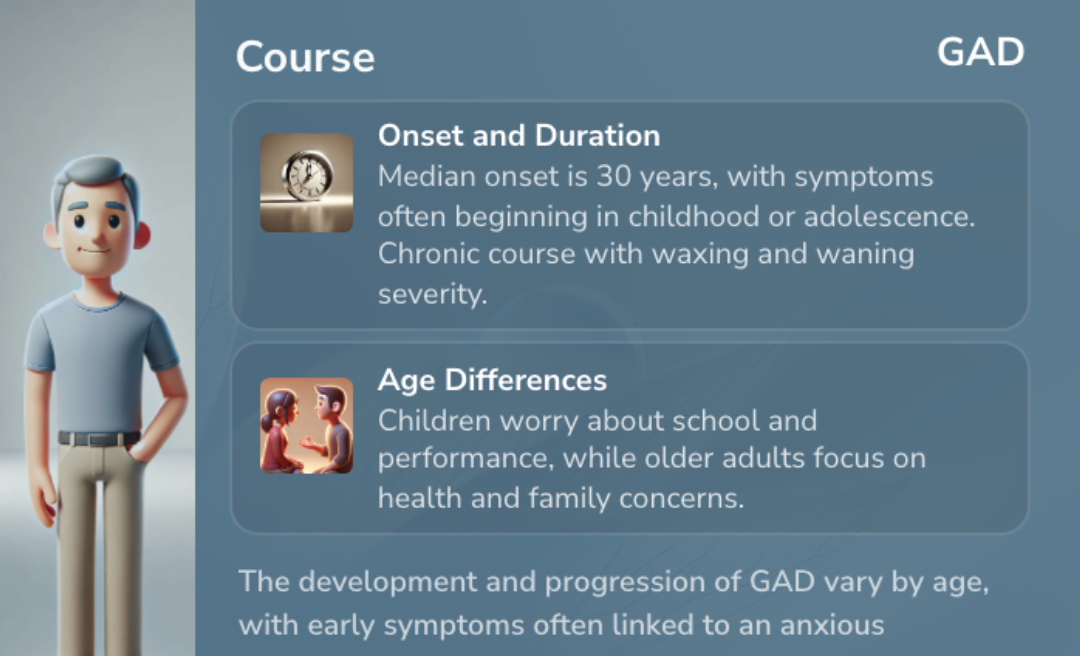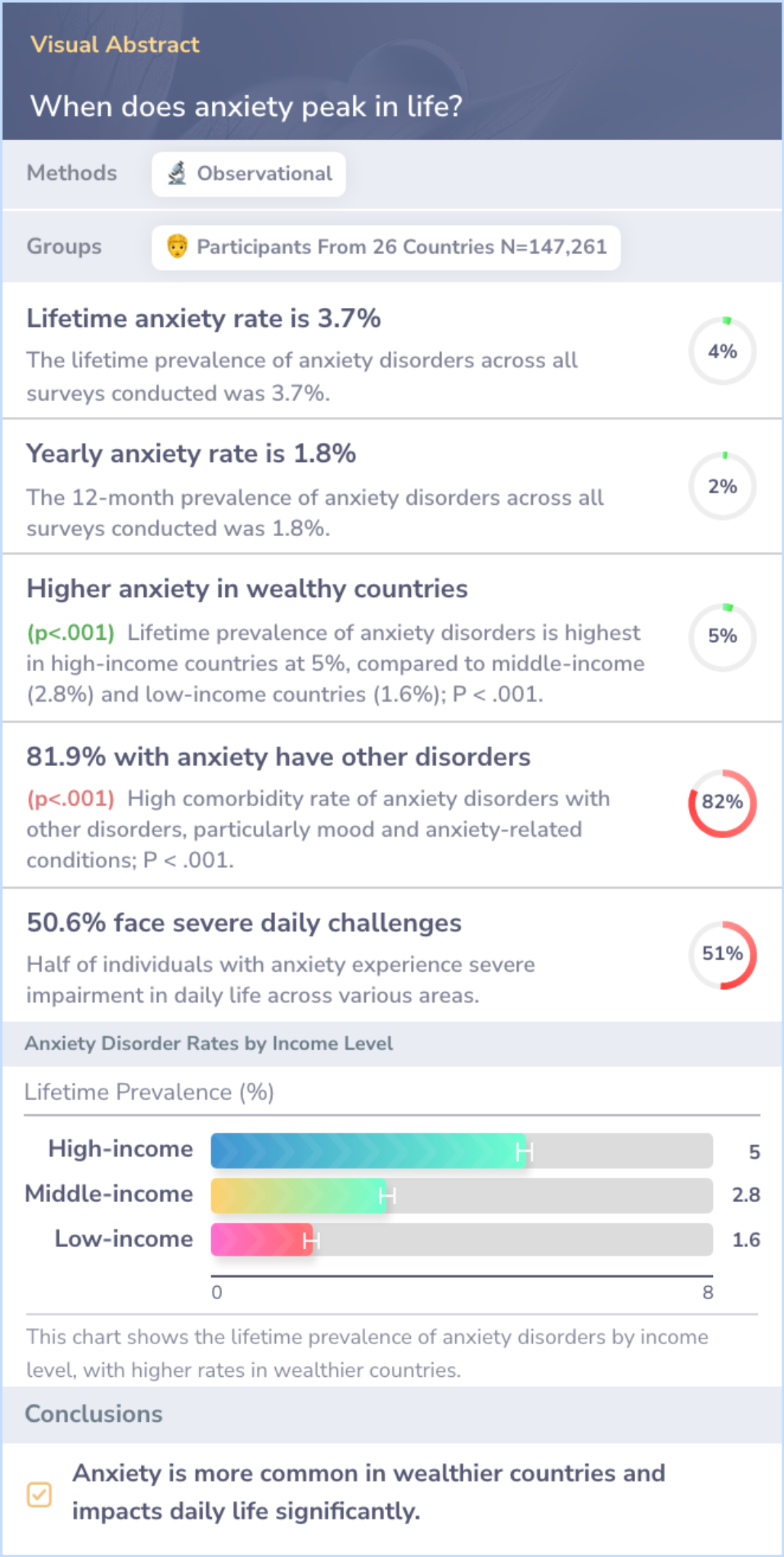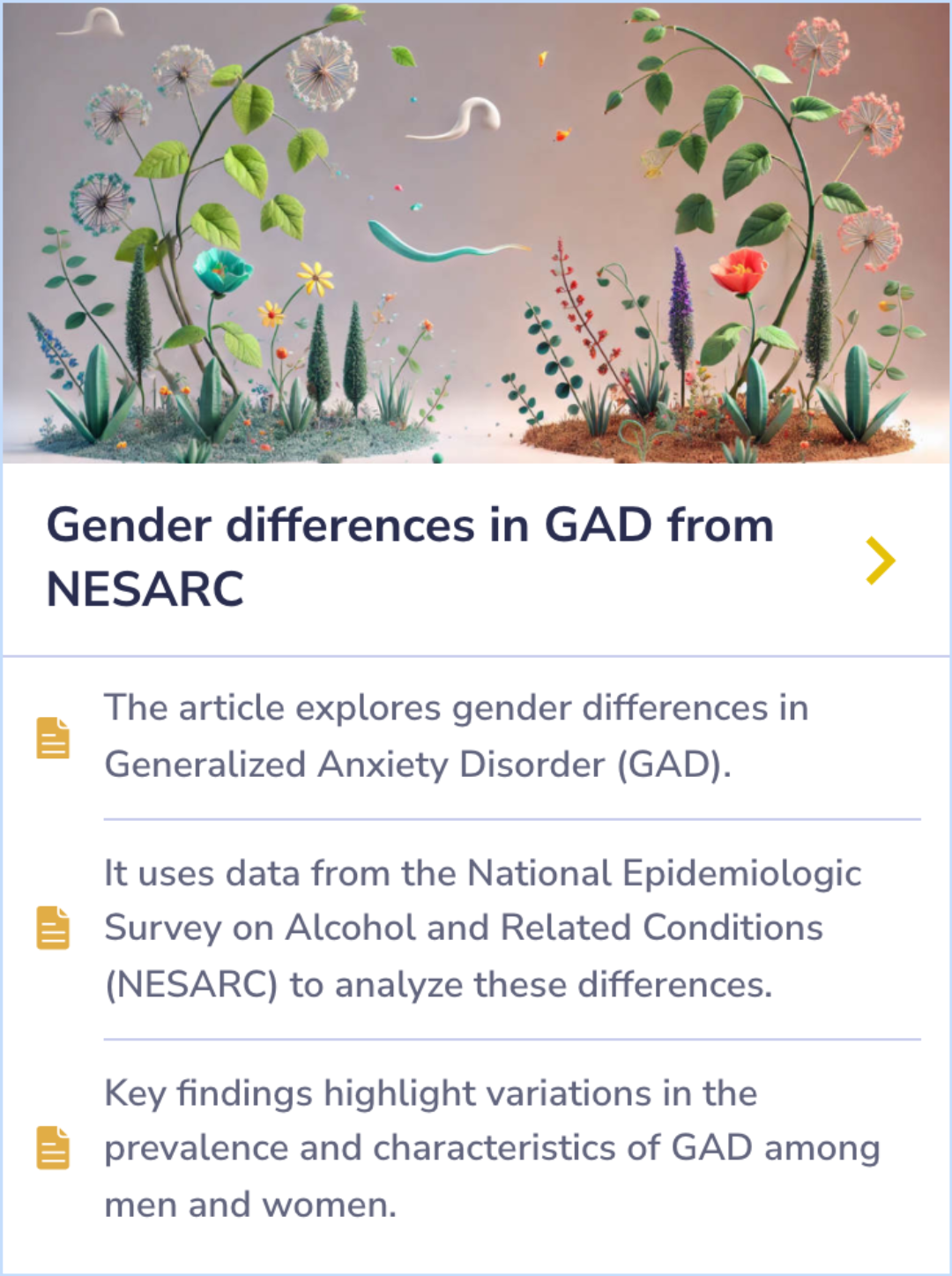Generalized Anxiety Disorder
Evidence Based Answers
When Does Anxiety Peak in Life?
Anxiety peaks in childhood and adolescence with social challenges, continues through early adulthood amid career and relationship pressures, and resurfaces in older adulthood with health issues and life changes.
Click to explore a section:

Anxiety's peaks vary, adolescence shows most increase, persists throughout life stages.
Studies Summary
🔄
Anxiety Often Before Depression
Many people experience anxiety before depression, with a noticeable overlap between the two conditions. This sequence is common in most cases.
📈
Life Cycle Patterns of Anxiety
Anxiety levels mirror life stages, peaking in adolescence and early adulthood, declining in middle age, and rising again in older adults.
🔍
Social Anxiety's Persistent Nature
Social anxiety shows low recovery rates, while panic disorder without agoraphobia tends to have better outcomes, especially when depression is not present.
Highly Cited Studies
Long term Effects of Methylphenidate in Adults
Peer Reviewed Study 1
Anxiety Often Starts Before Depression
Peer Reviewed Study 2
When Anxiety Peaks and How It Persists
Peer Reviewed Study 3
Anxiety Across Different Life Stages
Personal Experiences
Perspectives: When Anxiety Peaks in Life
In discussions on when anxiety peaks in life, perspectives highlight the complexity of this experience. Many point to specific life stages, such as young adulthood or midlife, as peaks, while others attribute anxiety to external societal factors or physiological changes.
Some argue that anxiety can worsen with age due to increased responsibilities and health concerns, while others believe proactive self-care and mindset shifts can lead to improvement.
Some argue that anxiety can worsen with age due to increased responsibilities and health concerns, while others believe proactive self-care and mindset shifts can lead to improvement.
Reddit: u/Wuffies
23-30. At least that's the age range I remember having palpitations and an inability to sleep for longer than 3 hour increments at a time... The anxiety hasn't gotten 'better,' but rather more managed now.Background: Childhood and Adolescence: Anxiety Takes Root
Anxiety often begins in childhood or adolescence, showing up as separation anxiety or social inhibition. While rare in young children, it becomes more common as social and academic demands grow.
Adolescence sees a noticeable increase in anxiety disorders like Social Anxiety Disorder (SAD), which often peak in the early teenage years.
Adolescence sees a noticeable increase in anxiety disorders like Social Anxiety Disorder (SAD), which often peak in the early teenage years.
“
Source Quotes:
Generalized anxiety disorder (GAD) typically presents in school age years, with a typical age of onset around seven years.,Social anxiety disorder (SAD) is most common in early adolescence even though social inhibition can occur early in development.
Background: Early Adulthood: Rising Anxiety Levels
Early adulthood is a time when anxiety disorders such as Generalized Anxiety Disorder (GAD) and panic disorder frequently emerge. This stage can involve challenges like career pressure, relationship changes, and financial stress.
Women tend to experience higher rates of anxiety during this period, with some individuals beginning a lifelong struggle with chronic anxiety.
Women tend to experience higher rates of anxiety during this period, with some individuals beginning a lifelong struggle with chronic anxiety.
“
Source Quotes:
The age at onset is highly variable; some cases of generalized anxiety disorder begin in childhood, most begin in early adulthood.
The age of onset for anxiety disorders differs among the disorders. Separation anxiety disorder and specific phobia start during childhood, with a median age of onset of 7 years, followed by SAD (13 years), agoraphobia without panic attacks (20 years), and panic disorder (24 years).
Background: Older Adults: Anxiety and Life Transitions
In older adults, anxiety often connects with chronic illnesses or significant life changes like retirement and bereavement. Late-onset Generalized Anxiety Disorder (GAD) is common in this group, highlighting a link between physical health and emotional well-being.
Although anxiety disorders generally decline after age 50, GAD remains prevalent and may require specific attention in older populations.
Although anxiety disorders generally decline after age 50, GAD remains prevalent and may require specific attention in older populations.
“
Source Quotes:
Late-onset GAD (onset >=50 years) is thought to represent the most common anxiety disorder among older adult populations.
After the age of 50, a marked decrease in the prevalence of anxiety disorders has been observed in epidemiological studies. GAD is the only anxiety disorder that is still common in people aged 50 years or more.
Background: Anxiety’s Changing Patterns Across Life
Anxiety levels follow a U-shaped curve, peaking in adolescence and early adulthood, dipping in middle age, and rising again in older adulthood. This trend mirrors life stages and their unique challenges, such as academic pressure, career demands, and health concerns.
Recognizing these patterns can help address the needs of individuals at different life stages.
Recognizing these patterns can help address the needs of individuals at different life stages.
“
Source Quotes:
Longitudinal data of anxiety prevalence in 1420 participants in North Carolina, United States, showed a U-shaped pattern from childhood to adulthood.
Another peak of new-onset cases occurs in older adulthood, often in the context of chronic physical health conditions.
Background: Age-Linked Anxiety Peaks
The development and progression of Generalized Anxiety Disorder (GAD) show significant age variations. The median onset of GAD is at 30 years, although symptoms often begin in childhood or adolescence. The severity of the disorder waxes and wanes over time, indicating fluctuating anxiety levels throughout life.
Differences in concerns based on age are noted, as children tend to worry about school and performance, while older adults are more focused on health and family matters. This highlights that anxiety can peak at different life stages, influenced by varying concerns and stressors.
Differences in concerns based on age are noted, as children tend to worry about school and performance, while older adults are more focused on health and family matters. This highlights that anxiety can peak at different life stages, influenced by varying concerns and stressors.

Peer Reviewed Study
Study: Anxiety Often Starts Before Depression
Anxiety often precedes depression in a significant number of cases.
Nearly three-quarters of individuals with anxiety also experience depression, showing strong overlap between the two conditions.
Understanding the onset timing and overlap helps guide future treatment strategies.
Nearly three-quarters of individuals with anxiety also experience depression, showing strong overlap between the two conditions.
Understanding the onset timing and overlap helps guide future treatment strategies.
author
Moffitt TE, Harrington H, Caspi A, Kim-Cohen J, Goldberg D, Gregory AM, Poulton R
journal
Arch Gen Psychiatry
Date Published
2007 Jun

Peer Reviewed Study
Study: When Anxiety Peaks and How It Persists
Anxiety disorders often follow a chronic course, with low recovery rates over time.
Social anxiety shows the lowest recovery rates, while panic disorder without agoraphobia has a higher chance of recovery.
Comorbid conditions, especially depression, worsen recovery outcomes.
Social anxiety shows the lowest recovery rates, while panic disorder without agoraphobia has a higher chance of recovery.
Comorbid conditions, especially depression, worsen recovery outcomes.
author
Bruce SE, Yonkers KA, Otto MW, Eisen JL, Weisberg RB, Pagano M, Shea MT, Keller MB
journal
Am J Psychiatry
Date Published
2005 Jun

Peer Reviewed Study
Study: Anxiety Across Different Life Stages
Anxiety disorders affect individuals at different rates depending on various factors.
Higher prevalence is seen in wealthier countries, with significant challenges for those experiencing severe forms.
Comorbid conditions and daily impairment are common, highlighting the widespread impact of anxiety.
Higher prevalence is seen in wealthier countries, with significant challenges for those experiencing severe forms.
Comorbid conditions and daily impairment are common, highlighting the widespread impact of anxiety.
author
Ruscio AM, Hallion LS, Lim CCW, Aguilar-Gaxiola S, Al-Hamzawi A, Alonso J, Andrade LH, Borges G, Bromet EJ, Bunting B, Caldas de Almeida JM, Demyttenaere K, Florescu S, de Girolamo G, Gureje O, Haro JM, He Y, Hinkov H, Hu C, de Jonge P, Karam EG, Lee S, Lepine JP, Levinson D, Mneimneh Z, Navarro-Mateu F, Posada-Villa J, Slade T, Stein DJ, Torres Y, Uda H, Wojtyniak B, Kessler RC, Chatterji S, Scott KM
journal
JAMA Psychiatry
Date Published
May 1, 2017

Key Takeaways
Conclusions
Anxiety peaks during adolescence and early adulthood, reflecting significant life transitions and challenges like academic pressure, career stress, and social expectations.
Adolescence marks an initial increase, with disorders like Social Anxiety Disorder emerging, while early adulthood introduces Generalized Anxiety Disorder and panic disorder, particularly among women. Later, anxiety resurges in older adults linked to health issues and life changes. Studies reveal anxiety disorders often intertwine with depression, following a persistent path with low recovery, especially in social anxiety.
Recognizing these patterns across life stages aids in addressing the widespread impact of anxiety.
Adolescence marks an initial increase, with disorders like Social Anxiety Disorder emerging, while early adulthood introduces Generalized Anxiety Disorder and panic disorder, particularly among women. Later, anxiety resurges in older adults linked to health issues and life changes. Studies reveal anxiety disorders often intertwine with depression, following a persistent path with low recovery, especially in social anxiety.
Recognizing these patterns across life stages aids in addressing the widespread impact of anxiety.

Evidence Summary
Gender Differences in ADHD and Associated Disorders
Analysis reveals gender differences in ADHD symptoms linked to other disorders. Boys show more signs of oppositional defiant and conduct disorder while girls have higher rates of separation anxiety, especially with ADHD's inattentive subtype. Both boys and girls with the combined subtype consistently show more comorbid symptoms.
For those without ADHD, girls have higher rates of separation anxiety, with boys and girls differing in speech therapy needs. Interestingly, generalized anxiety disorder appears more in girls with the combined subtype.
For those without ADHD, girls have higher rates of separation anxiety, with boys and girls differing in speech therapy needs. Interestingly, generalized anxiety disorder appears more in girls with the combined subtype.
Evidence Summary
Gender-Based Insights into Generalized Anxiety Disorder
Generalized Anxiety Disorder (GAD) affects men and women differently, with notable variations in how the condition presents and persists. This analysis sheds light on gender-based differences, using comprehensive data from the NESARC to reveal unique aspects of GAD’s prevalence and characteristics across genders.
The findings underline how men and women may experience and report symptoms in distinct ways, contributing to broader insights into the disorder’s impact on each gender.
The findings underline how men and women may experience and report symptoms in distinct ways, contributing to broader insights into the disorder’s impact on each gender.
Evidence Summary
Global Patterns of GAD and Co-Existing Conditions
Generalized Anxiety Disorder (GAD) affects people globally, with rates varying across countries. The DSM-5 manual offers a standardized approach to identifying and diagnosing GAD, creating consistency in how it is recognized.
Research reveals that GAD often coexists with other mental health conditions, adding complexity to its treatment and management.
The global prevalence highlights the widespread nature of this condition and its overlapping challenges.
Research reveals that GAD often coexists with other mental health conditions, adding complexity to its treatment and management.
The global prevalence highlights the widespread nature of this condition and its overlapping challenges.


